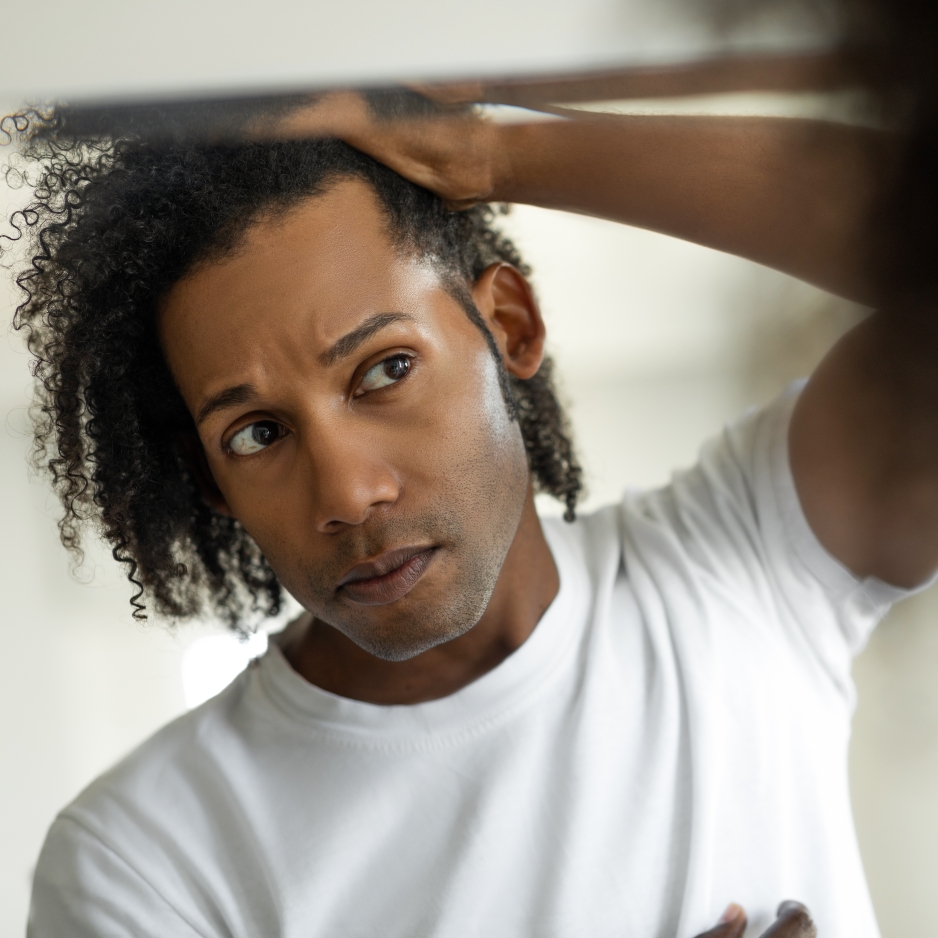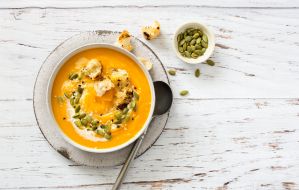The Magic Power Of Pumpkins - From Spooky Halloween To Healthy Hair
Posted by Rali Bozhinova, Superintendent Trichologist
In this article: Hair Facts! | Hair Loss | Male Hair Loss | Women's Hair Loss
Written by Rali Bozhinova, Superintendent Trichologist, The Belgravia Centre
The cosy season has officially begun! The leaves are painted in gold and red, the days are shorter and colder, and we spend more time cuddled up in a blanket. We’re in the midst of autumn. And with autumn comes pumpkins! Of course, pumpkins make great jack-o'-lanterns but they’re not just for Halloween decoration. They are rich in many nutrients important for your hair. This year when you’re carving your pumpkins, keep the peel, pulp, and seeds - you may be surprised by their benefits. Here are several reasons why:
Iron
Iron is a commonly discussed mineral in the world of hair loss. Pumpkin peel, fruit and seeds are good sources of iron. It is vital for the normal formation of red blood cells and haemoglobin. It contributes to oxygen transport in the body and has a role in the process of cell division. Low iron is fairly common – this could be due to a diet that is not rich in iron, such as vegan or some vegetarian diets; it could be due to less iron absorption, especially in those with gastrointestinal disorders; or sometimes due to blood loss, especially in women with heavy menstrual cycle. Hair loss is a common symptom of low iron, as well as tiredness and difficulty concentrating. Low ferritin levels have been associated with telogen effluvium and female pattern hair loss.

Telogen effluvium happens when many actively growing hair follicles are pushed prematurely to the end of their cycle, losing their hair quickly. If you have telogen effluvium, you may notice excessive hair shedding from all over your scalp, you may find your hair on the floor, on your desk and on clothes throughout the day. Fortunately, if this is caused by low iron, telogen effluvium has the potential to recover on its own within 3-6 months after the iron levels improve. However, if it continues for over 6 months it can become chronic and subsequently very upsetting to experience. It can lead to reduced hair density, you may feel like your hair does not grow in length, and it can also aggravate any other underlying hair loss condition.
Female pattern hair loss, on the other hand, is a condition that only affects specific areas of your scalp – the front hairline may feel thinner, you may see more of your scalp when you part your hair, and your crown may appear with less volume, whilst the hair at the back of your head may still feel dense. Iron deficiency is not a causative factor for female pattern hair loss because this is a genetic condition. However, low iron may aggravate it further and many women tend to benefit from improving their iron levels whilst receiving treatment for female pattern hair loss.
Antioxidants
Pumpkin flowers, pulp, and seeds are excellent sources of antioxidants that can protect cells from oxidative stress. Your hair and scalp are often exposed to oxidative stress from air pollution, cigarette smoke, and sun exposure. It is also a natural part of ageing. As a result, you may see various changes in your hair such as greying of the hair, hair thinning, and hair loss. Immune cells are also sensitive to oxidative stress and some studies suggest that people with alopecia areata, an autoimmune hair loss condition, have elevated levels of oxidative stress and reduced levels of antioxidant enzymes. Consuming antioxidants as part of your diet is therefore important to maintain normal immune health and cell signalling. Pumpkins are a rich source of antioxidants such as vitamin A, vitamin C, vitamin E and Zinc.
Vitamin A is a fat-soluble vitamin. Excessive intake of vitamin A can be toxic and can lead to hair loss. However, a balanced diet should provide just the right amount of vitamin A important for healthy skin and hair. The pumpkin peel and pulp are a source of beta-carotene, a precursor to vitamin A and an antioxidant. Once consumed, your body will only convert it to as much vitamin A as it needs.

Vitamin C is a water-soluble vitamin and an important antioxidant. It is vital for the formation of collagen and wound healing. These are two important factors for a healthy scalp and hair. Collagen is a protein that makes your skin strong and elastic. With age, collagen production naturally declines and this can change the environment of the hair follicles on your scalp. The hair follicles may find it more difficult to move up and down in the dermis during the hair growth cycle and this may result in thinner hair over time. Vitamin C also helps you absorb iron better and since your body can’t synthesise vitamin C, it is important to have this in your diet.
Vitamin E, similarly to vitamin A, is a fat-soluble vitamin. It is important for healthy skin, including that on your scalp. It has an anti-inflammatory effect and has been found helpful in the treatment of atopic dermatitis. Additionally, the Malassezia yeast, one of the microorganisms that is part of the natural scalp microbiome, is another source of oxidative stress. In some people, this is associated with scalp itching, inflammation, and dandruff. Although it is not a hair loss condition, the constant friction from scratching can cause hair loss and breakage. A healthy scalp is vital for healthy hair.
Zinc is an essential mineral – your body does not make zinc and therefore, you require a small amount of zinc in your diet daily. It is important for gene expression, healthy immune function, wound healing, cell division, normal metabolism, and healthy hair. Together with vitamin C, zinc is also important for collagen synthesis. Low levels of zinc can be associated with telogen effluvium, alopecia areata, female pattern hair loss, and slower wound healing.
DHT-Reducing Effects
Pumpkin seeds are a source of phytosterols – compounds found in many plants that come with multiple benefits such as reducing cholesterol, helping reduce symptoms of benign prostatic hyperplasia, and it may help with some symptoms associated with menopause. The phytosterols of pumpkin seed oil have gained popularity due to their anti-androgenic effects. Androgens are your male sex hormones. The main circulating androgen in the blood is testosterone. In the presence of 5-alpha reductase enzyme, testosterone converts to a very potent androgen called dihydrotestosterone (DHT). DHT, as many of you may be aware, is a hormone involved in androgenic alopecia – this includes both male and female pattern hair loss.

Androgenic alopecia is the most common type of hair loss. It has genetic predisposition and the DHT hormone is closely involved. DHT makes the hair follicles across the front hairline, top and crown of the scalp become smaller and weaker over time, growing thinner hair with every following hair growth cycle. You may experience reduced hair density, especially on top of your scalp. Many men may notice receding hairline. Women with long hair may feel like their ponytail is smaller. Eventually, some follicles may be lost leading to more advanced stages of the condition.

The phytosterols of pumpkin seed oil have been found to inhibit some of the 5-alpha reductase enzyme activity and thus, reduce the conversion of testosterone to DHT. This is a similar effect to that of finasteride, a medically proven treatment for male pattern hair loss. The pumpkin seed oil has therefore gained a special interest in trichology and has been studied as a potential supplement in the treatment of androgenic alopecia.
In 2014 a Korean study explored the efficacy of taking 400mg pumpkin seed oil per day in the treatment of mild to moderate male pattern hair loss classified as Norwood-Hamilton type II, III, III Vertex, IV, and V. They compared two groups of men with androgenic alopecia – the first group was the control who received a placebo capsule daily for the duration of 6 months; the second group received 400mg pumpkin seed oil capsule also for the duration of 6 months. At the end the researchers found that the mean hair count increased by 40% in the pumpkin seed oil group, whilst the mean hair count increased by 10% in the placebo group. Some variations in hair count are normal as part of the hair growth cycle however, this study demonstrated that those using pumpkin seed oil noticed better hair density after 6 months.
In 2021 the Journal of Cosmetic Dermatology also published a study comparing the effects of topical pumpkin seed oil and topical minoxidil on women diagnosed with female pattern hair loss classified as Ludwig I and II. Group A consisted of 30 women who used 1ml of topical pumpkin seed oil once daily for 3 months. Group B had 30 women who used 1ml of topical minoxidil 5% foam once daily for 3 months. The hair results were evaluated with a dermoscope and demonstrated that both groups experienced some improvement but the minoxidil had higher efficacy than pumpkin seed oil. This study, unfortunately, had several limitations – it had a very small number of participants, there was no control group to evaluate the natural changes that occur as part of the hair cycle, and also 3 months is a very short period of time for significant changes in hair density.
First Signs Of Hair Loss?
As you can see, pumpkins have many health benefits and they are not just for decoration. Keep the pulp and seeds this Halloween and treat yourself to a delicious pumpkin recipe full of wonderful nutrients for healthy hair. Roast the seeds and use them for a healthy snack while watching a Halloween movie. Use the pulp for a flavoursome pumpkin soup to keep you warm this autumn.

Although you can certainly enjoy all these delightful pumpkin nutrients, if you notice any signs of hair loss, pumpkins won’t be enough to treat this. You should always consult with a hair loss specialist who will collect all necessary information from you before they recommend a treatment plan tailored to your specific situation. They will examine your hair, collect your medical history and discuss your lifestyle. If they suspect any dietary deficiency, they may also recommend you to do a blood test. For those with androgenic alopecia, ongoing treatment plan may be discussed. Although pumpkin seed oil may help you grow more hair, androgenic alopecia is a long-term type of hair loss and more studies are needed on the efficacy, safety and administration of pumpkin seed oil. So far, the only two medically proven treatments for this are minoxidil (suitable for men and women) and finasteride (suitable for men only).
The Belgravia Centre’s pharmacy prepares special formulations of minoxidil at different strengths, and with various additives to maximise effectiveness, whilst finasteride can be used orally or topically. We also offer other natural and technological solutions that are combined to provide the optimum solution to prevent hair loss, and an exceptional level of expertise. One of our 20 qualified hair loss specialists will be available to help you any time at our Central London clinic or through a Zoom consultation if you live outside of London.

If you are worried about hair loss you can arrange a free consultation with a hair loss expert or complete our Online Consultation Form from anywhere in the world. Take a look through our hair regrowth photo gallery – which is the largest gallery of its kind in the world and contains over 1,000 sets of hair growth photos and verified reviews from patients of The Belgravia Centre.

The Belgravia Centre
The Belgravia Centre is a world-renowned group of a hair loss clinic in Central London, UK. If you are worried about hair loss you can arrange a free consultation with a hair loss expert or complete our Online Consultation from anywhere in the world for home-use treatment.
View our Hair Loss Success Stories, which includes the world's largest gallery of hair growth photos and demonstrates the level of success that so many of Belgravia's patients achieve.
Posted by Rali Bozhinova, Superintendent Trichologist
In this article: Hair Facts! | Hair Loss | Male Hair Loss | Women's Hair Loss
